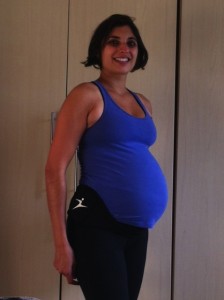When should I stop my normal pre-pregnancy exercise routine?
We get a lot of emails from pregnant ladies who are worried about losing their fitness whilst pregnant. They have been working out and love their current exercise routine but obviously want to look after the baby too. Well the best way to look after baby and yourself is to keep exercising but modify as you progress through pregnancy.
Years ago, the advice was for pregnancy ladies to stop all exercise and to pretty much go on bed rest. Then this changed to a focus on only low impact exercise. However now we know from the recent research that exercise in pregnancy is a good thing, but that pregnant ladies tend to reduce their exercise. In the first trimester the advice is that you shouldn’t take up a NEW form of exercise, but this seems to sometime get misconstrued into “I must not exercise”. What this advice actually means is “Keep doing your normal exercise routine as much as you can/feel ok to do so”. Of course the nausea, tiredness and pregnancy hormones may mean you find exercising harder than normal, but some ladies do find doing exercise can help them through this trimester.
A study on over 1,000 pregnant ladies showed the rate pf physical activity was lower in pregnancy (20.1%) and that less than half received exercise advice in pregnancy (47.4%). Yes, when you are pregnant it is absolutely important to look after the baby, but part of that is looking after your own body so it is strong, fit and able to cope with not just the demands of pregnancy but of being a mum. Carrying, lifting, feeding, rocking and crawling after a small person is pretty tough on the body.
So can you continue your normal exercise routine? Yes to an extent. You will need to seek advice and modify some things. I was teaching spin until 7 months pregnant with my first baby and I taught Step Aerobics until 2 days before baby 1 and 1 week before baby 2. Through my 3rd pregnancy daily Pilates and functional work kept me strong and sane. Maybe surprisingly (or not) doing more Pilates and functional work lead to the pregnancy with the least aches and complications and a simple homebirth. So I’m not saying that you need to be running or cross-fitting your way through pregnancy, but that many forms of exercise can be adapted for you to continue whilst pregnant.
I have ladies who have run through pregnancy, who have continued to lift weights and to do modified cross fit. For all these ladies they have naturally tapered their levels of impact and exertion down as needed. Running may become a slow job with some walking, weights can be lighter and the range of movement smaller, cross fit moves can have some of the impact taken out.
All exercise needs to have a strong core as a foundation, this is even more important in pregnancy and postally. So for me, Pilates is essential as part of an exercise routine, but it doesn’t have to be the only thing you do. Having said that, it could be! Our pregnancy classes include whole body functional movements such as lunges, squats, wall press ups and wall planks that ensure our mums are working those global muscles as well as the core. It isn’t all breathing!
The 4 keys:
1. Listen to your body. When you feel hot, tired or just not right then stop.
2. Seek the advice of a trained exercise professional who knows their stuff. Someone who knows about pregnancy and if they don’t knows where to get help.
3. Expect to make modifications.
4. Keep your core strong. This is your foundation, with your abdominals being stretched and your pelvic floor taking a heavy load you need to have more focus on this. A specific Pilates class will do this for you or check out our DVD.


